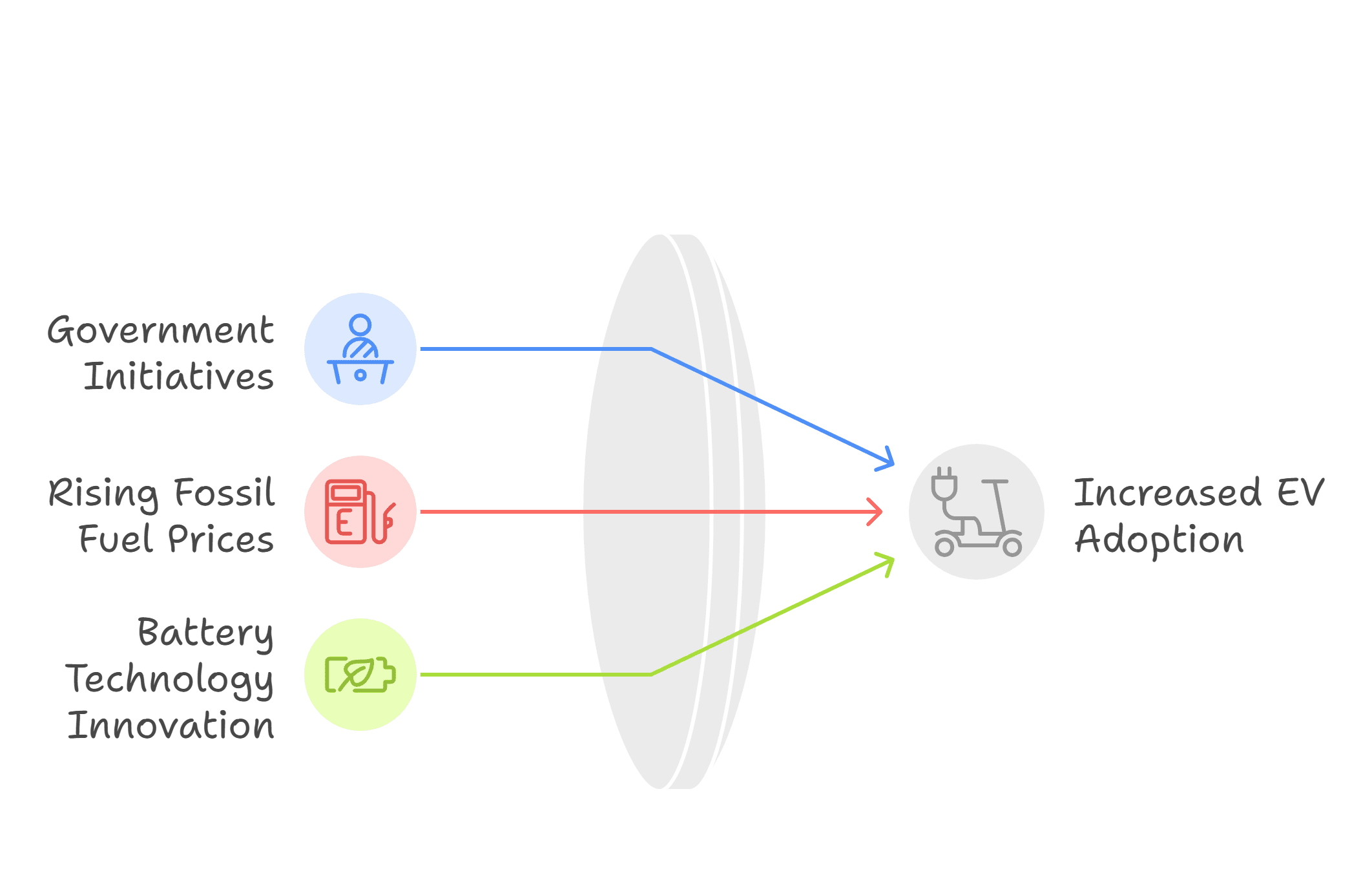Adoption of green and renewable energy sources is the need of the hour as these sources are better than conventional sources of energy for two reasons. These sources of energy are cleaner than conventional sources of energy and, hence, do not pollute the environment. Furthermore, traditional energy sources are depleting, which makes switching to renewable energy sources essential. Due to these two reasons, the demand for green and renewable energy will increase, presenting investors with attractive investment opportunities.
In this blog, we will give you an overview of top green and renewable penny stocks and the benefits and disadvantages of investing in them.
What are Green and Renewable Energy Penny Stocks?
The renewable energy sector includes companies that use renewable energy sources, such as hydropower, solar, wind, and biomass, to generate energy. Some of these companies are listed on the Indian stock exchange and are trading below ₹100. These sources provide clean and sustainable energy, which helps fight climate change and cut carbon emissions.
Many countries are launching various subsidies and policies to promote companies engaged in the green and renewable energy sector. The Government of India has allocated ₹19,700 crores to the Green Hydrogen Mission, ₹10,000 crores to set up 500 new waste-to-wealth plants, etc., in Budget 2023. The government has also allowed 100% Foreign Direct Investment (FDI) under the automatic route in renewable energy projects in India.
Read Also: Top 10 Steel Penny Stocks in India
List of Best Green and Renewable Energy Penny Stocks in India
- Orient Green Power Company Limited
- Jai Prakash Power Ventures Limited
- Urja Global Limited
- Indowind Energy Limited
- Energy Development Company Limited
| Company | Current Market Price (in ₹) | Market Capitalization (in ₹ Cr.) | 52-Week High (in ₹) | 52-Week Low (in ₹) |
|---|---|---|---|---|
| Orient Green Power Company Limited | 18.3 | 2,142 | 32 | 16.6 |
| Jaiprakash Power Ventures Limited | 19.2 | 13,172 | 24 | 12.2 |
| Urja Global Limited | 18.8 | 988 | 41.8 | 12.1 |
| Indowind Energy Limited | 24.8 | 319 | 32.7 | 18.2 |
| Energy Development Company Limited | 30 | 142 | 36.8 | 18.9 |
Best Green and Renewable Energy Penny Stocks – An Overview
An overview of the best Green and Renewable Energy Penny Stocks in India is given below:
1. Orient Green Power Company Limited
Established in 2006 as a division of the Shriram Group, Orient Green Power Company Limited is dedicated to the development of sustainable energy projects. Wind energy was added to the company’s energy portfolio later that year (2008). The business went public in 2010 to pay off its debt and invest in new biomass projects. Today, it ranks among the biggest wind energy power producers. In Tamil Nadu, Andhra Pradesh, Gujarat, and Karnataka, the company runs a number of wind farms. Recently, the company has diversified into solar energy and is planning to develop solar projects with a capacity of 39.6 MW. Its headquarters are located in Chennai.
Know the Returns:
| 1Y Return (%) | 3Y Return (%) | 5Y Return (%) |
|---|---|---|
| -15.26% | 59.41% | 905.79% |
2. Jaiprakash Power Ventures Limited
Jaiprakash Power Company was established in 1994 as a subsidiary of the Jaypee Group and was then known as Jaiprakash Hydro-Power Limited. The company changed its name to Jaiprakash Power Ventures Limited in 2009 after merging with another Jaypee Group entity. The business launched its initial public offering (IPO) later in 2010 and utilized the money it generated to fund its expansion and growth initiatives. The company operates thermal and hydropower projects and has a 400 MW Vishnuprayag Hydro-Electric plant in Uttarakhand. Its corporate office is located in New Delhi.
Know the Returns:
| 1Y Return (%) | 3Y Return (%) | 5Y Return (%) |
|---|---|---|
| 31.35% | 263.14% | 1,222.86% |
3. Urja Global Limited
The business was founded in 1992 to offer renewable energy solutions. Later, in 2000, the company expanded its line of products to include renewable energy to capitalize on the growing need for clean energy solutions. The Urja Global Limited company’s product range includes solar batteries, inverter batteries, e-rickshaws and electric scooters. The company’s wide range of solar products, including solar home lighting systems, solar street lighting systems, solar PV panels, etc., makes it the market leader in the solar industry. Its main office is located in New Delhi.
Know the Returns:
| 1Y Return (%) | 3Y Return (%) | 5Y Return (%) |
|---|---|---|
| 16.61% | 32.10% | 858.95% |
4. Indowind Energy Limited
The Indowind Company was established in 1995 with the goal of producing energy using wind and becoming a key player in India’s renewable energy industry. The firm began establishing different wind farms in Southern India in the year 2000. In 2007, the business launched its initial public offering (IPO) and raised money for expansion. The company announced a rights issue in 2023 to pay off bank loans and for expansion. In addition to expanding its wind power capacity, the company also offers third-party operational support. The headquarters of Indowind Energy Limited are located in Chennai, Tamil Nadu.
Know the Returns:
| 1Y Return (%) | 3Y Return (%) | 5Y Return (%) |
|---|---|---|
| 18.94% | 8.69% | 864.89% |
5. Energy Development Company Limited
The EDCL was founded in 1995 with a focus on renewable energy development. The company raised money by going public in 2006 and got listed on Indian stock exchanges. It currently has 19 MW of renewable energy capacity and has hydroelectric projects with a capacity of 291 MW under development. Moreover, the company aims to develop hydropower infrastructure with a capacity of 500 MW. The company’s focus is on streamlining its operations and increasing the efficiency of its electricity generation. Its main office is located in Kolkata.
Know the Returns:
| 1Y Return (%) | 3Y Return (%) | 5Y Return (%) |
|---|---|---|
| 13.09% | 31.22% | 432.36% |
Read Also: Reliance Penny Stocks List in India
Key Performance Indicators (KPIs)
| Company | Operating Profit Margin (%) | Net Profit Margin (%) | ROE (%) | ROCE (%) | Current Ratio |
|---|---|---|---|---|---|
| Orient Green Power Company Limited | 42.05 | 14.17 | 4.63 | 7.98 | 1.08 |
| Jaiprakash Power Ventures Limited | 31.93 | 15.11 | 13.33 | 13.91 | 1.82 |
| Urja Global Limited | 7.89 | 4.57 | 1.17 | 1.48 | 1.42 |
| Indowind Energy Limited | 27.41 | 18.30 | 3.08 | 3.74 | 0.80 |
| Energy Development Company Limited | 25.57 | -7.22 | -2.14 | 4.16 | 0.77 |
Benefits of Investing in Green and Renewable Energy Penny Stocks
The benefits of investing in green and renewable penny stocks are as follows-
- Growth Potential – The green and renewable sector is growing rapidly, and the penny stocks of companies operating in this sector have significant growth potential.
- Low Entry – The prices of the penny stocks are significantly low, hence providing you an opportunity to begin investing without significant capital.
- Diversification – One can diversify their portfolio and reduce their risk by having exposure to the renewable energy sector.
- Early Stage – The penny stocks are issued by companies that are in the early stages, offering individuals an opportunity to grow their investments as the company expands its operations.
- Favorable Government Policies– Governments across the world are incentivizing companies engaged in the production of renewable energy through favorable policies, subsidies, etc.
- Demand – The demand for renewable energy is rising due to an increased focus on sustainability.
Read Also: Top 10 Highest Dividend Paying Penny Stocks in India
Disadvantages of Investing in Green and Renewable Energy Penny Stocks
The disadvantages of investing in green and renewable penny stocks are mentioned below-
- Volatility – The prices of the penny stocks engaged in the renewable energy industry fluctuate a lot, which can lead to losses.
- Low Liquidity – Penny stocks generally have low trading volumes, which makes it difficult for investors to buy or sell the stock.
- Business Risk – Various penny stocks of the renewable energy sector lack financial stability and face operational risks.
- Technological Advancement – Companies engaged in the renewable energy sector need to continuously develop the latest technologies, which creates difficulty for them in scaling their operations.
How to Invest in Green and Renewable Penny Stocks?
If you are looking to invest in penny stocks of green and renewable energy companies, then you must follow the below-mentioned steps –
- The first step would be doing proper research about the green and renewable energy sector, and, after this shortlist the companies that you find have the potential to perform in the long run.
- Then you need to open a demat account.
- Visit the website of Pocketful.
- Click on the Open Demat Account Tab.
- Complete your KYC and fill in all the relevant details required by the pocketful team.
- Submit the bank details and scanned copies of other relevant documents such as PAN card, identity proof, address proof, etc.
- After successful verification of documents, your demat account is opened.
- You will receive the login credentials on your registered mail ID.
- Then, you have to visit the website again and click on the Login Section on the Home Page or use our mobile application to access your account.
- Once you log into your demat account, search the penny stocks of green and renewable energy companies and purchase them.
Future in India
Technological advancements and the government’s focus on renewable energy sources bode well for India’s renewable energy industry. Given its wealth of energy resources, India might be considered a leader in the transition to renewable energy. The government is also focusing on providing a variety of incentives to help this sector. Therefore, this sector has immense potential to perform in the near future.
Read Also: 10 Best FMCG Penny Stocks in India
Conclusion
To sum up, switching to renewable energy sources can be a significant step in combatting climate change, due to which the green and renewable energy industry is poised for rapid expansion in the years to come. As a result, investing in leading green energy companies gives you the chance to make a healthy profit. Before making any investment decisions, you should do adequate research and speak with an investment advisor.
| S.NO. | Check Out These Interesting Posts You Might Enjoy! |
|---|---|
| 1 | Best Pharma Penny Stocks List Under ₹50 |
| 2 | Top 5 PSU Penny Stocks List in India |
| 3 | Mukesh Ambani Penny Stocks List |
| 4 | Best Alcohol Penny Stocks in India |
| 5 | Top 10 Cement Penny Stocks in India |
Frequently Asked Questions (FAQs)
Which penny stocks are related to green and renewable energy?
Some of the penny stocks related to the green and renewable energy sector are Orient Green Power Company Ltd., Jaiprakash Power Ventures Ltd., Urja Global Ltd., Indowind Energy Ltd., and Energy Development Company Ltd.
Is it safe to buy green energy stocks?
Investors can consider buying green energy stocks, as they have great potential to perform in the long run due to the focus on shifting from conventional energy to renewable energy and government incentives. However, it is advised to conduct a thorough analysis before investing.
In terms of revenue, which Indian company is considered number one in the renewable energy sector?
Adani Green Energy Limited is considered the largest producer of green energy in India.
Are there any risks related to investing in green and renewable energy companies?
Yes, there are various risks related to investments made in renewable energy companies, such as fluctuating profitability of the company, technological disruptions, changes in government policies, etc.
What are the sources of renewable or green energy?
The sources of clean or renewable energy are solar, wind, hydro, bio-gas etc.





















